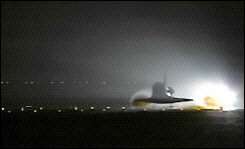Foam Issues Still Dog Shuttle Launch

Potential problems with the insulating foam covering the main fuel tank continue to occupy a great deal of time for and attention by NASA's space shuttle mission managers enough so that the orbiter's prospects for launch during its window in May remain uncertain.
At a briefing at Kennedy Space Center on Tuesday, NASA officials described the extensive testing, both via computer simulations and in wind tunnels, they have been conducting to attempt to minimize the risk that dangerously large pieces of foam will break off and damage the spacecraft.
A piece of foam as big as a briefcase broke off during the launch of shuttle Columbia in January 2003. Traveling at about 500 miles per hour, the piece smashed a hole into the leading edge of Columbia's left wing. That hole allowed super-heated gases to enter the wing's interior, and caused the orbiter to break up over the southwestern United States when it attempted to re-enter Earth's atmosphere the morning of Feb. 1. The accident cost the lives of the seven Columbia crew members.
NASA currently is looking at a 12-day mission for shuttle Discovery to the International Space Station. This will be the second leg of NASA's return-to-flight program for the shuttle fleet, which the agency plans to use for at least four more years to complete the assembly of the station.
Before that happens, however, they are attempting to make sure that pieces of foam will not cause a repeat of the Columbia disaster.
When shuttle Discovery lifted off last July, 16 significant pieces of foam insulation broke off the main tank. Although none was seen to hit the orbiter, NASA engineers became concerned enough to commence what has become an extensive testing effort.
"Foam will still come off the tank," Wayne Hale, deputy manager of the shuttle program, told reporters at the briefing, "but we believe that pieces that will come off will be small."
Hale described how engineers have been looking for places to reduce the amount of foam to reduce the risk that pieces will break off. "The task ahead of us is to ensure that all of these very small pieces of foam - most of them less than an ounce – will be of a size that they cannot have enough energy to do damage if they strike the orbiter."
He said engineers were trying to eliminate critical foam loss, "but you will expect to see foam coming off this next tank, and as we go forward (with) the next several flights, we will continue to make improvements, so we can eliminate even smaller and smaller pieces of foam loss."
Another potential problem involves a small piece of material in Discovery's pre-valve screen, a filter along the fuel system feeding the main engines. The particle apparently has lodged in a filter, and engineers are trying to decide whether it poses a hazard.
"The concern is that you have a piece that is large enough to get down in the engine, and actually stop up something that's vital," Hale said. "The pieces that we're looking at right now … are clearly small enough that we're not worried about them."
He explained that although cleaning the screen "sounds simple," it's actually a complicated process that would require opening up a significant segment of the shuttle's fuel system - and itself risks contaminating a fuel line.
Meanwhile, work is proceeding on getting Endeavour and Atlantis - NASA's other two orbiters - ready for launch later this year. "If we can fly (Discovery) in May or July," Hale said, "I'm confident we can get three flights off this calendar year - but time will tell."
Michael Leimbach, the shuttle launch director, pronounced Atlantis "in good shape," and ready to stand by as a rescue vehicle, should anything go wrong with Discovery's flight.
"I would like to have the ISS life-support system be capable enough that it could stand as the rescue vehicle (for shuttle crews) during the course of normal flights," Hale added.
Regarding Discovery's tank, for the past several days it has been en route via seagoing barge from its Michoud, La., assembly plant. Leimbach said the barge was approaching the Cape and should arrive as early as Wednesday afternoon, local time.
Hale praised the workers at the Michoud plant, near New Orleans, who have persevered despite personal losses and crises brought about by Hurricane Katrina last fall. "The fact that they can and do come to work every day and have done such incredibly precise and sophisticated work in turning out this spaceflight hardware that meets every test is just a testimony to them," he said.
Copyright 2006 by Space Daily, Distributed United Press International















